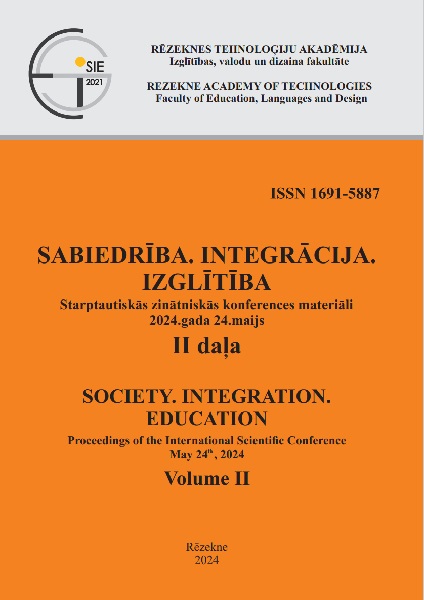JOB SHADOWING AS A METHOD IN FURTHER EDUCATION
DOI:
https://doi.org/10.17770/sie2024vol2.7916Keywords:
Career Building, Further Education, Job Shadowing, Professional DevelopmentAbstract
In response to the advanced shifts within the professional era, this study underscores the novel application of job shadowing as a medium of further education. By providing an understanding of the shifting requirements for practical knowledge in career building, this research represents the various scenarios of job shadowing for advanced professional growth. This study employed a mixed-methods approach employed quantitative surveys and qualitative interviews. The responses of 63 professionals from various industries involved in job shadowing were thoroughly analysed. The responses demonstrate the significant impact of job shadowing on acquiring skills and developing career trajectories. The respondents emphasise the importance of acquiring extensive practical knowledge, obtaining precise and reliable information about various professional job positions, and increasing their confidence to the most extent. Further, job shadowing is also helpful in expanding professional networks. This approach also contributes to a broader scenario on career-building journeys. Other than these positive outcomes, challenges were also underlined. These include a limited number of opportunities and not enough knowledge of employees in this field. This study represents the shifting position of job shadowing and recommends practical suggestions for establishing its efficiency in the professional corporate world. This study provides a detailed overview of the benefits, challenges, and solutions aligned with job shadowing. The study also highlights the important role of new strategies in further education in the recent discussion.
References
Abe, S., Yoshizo Matsuka, Murakami, A., Marianito, O., Oka, K., Okawa, T., Mihara, C., Shinohara, C., & Kawano, F. (2022). Job shadowing for early undergraduate dental students: Evaluation and validation of educational effectiveness using structural equation modelling. https://doi.org/10.1111/eje.12880
Danijela, M. (2021). Learning Potentials of Job Shadowing in Teacher Education. International Journal of Learning, Teaching and Educational Research, 20(12), 255–266. Retrieved from: http://ijlter.net/index.php/ijlter/article/view/758
Diz, E. (2018). The Shadowing Project (TSP): a new didactic tool for 21st century European graduates combining PBL, CLIL, and Job Shadowing practices. INTED2018 Proceedings, 2081–2089. https://doi.org/10.21125/inted.2018.0389
English, N. (1997). Job Shadowing As A Mechanism For College And Career Readiness. Retrieved from: http://d-scholarship.pitt.edu/33145/1/8.7%20SD%20Neil.English.ETD.7.2.18.FINAL%20COPY%2097-03.pdf
Frost, J. D. (2016, May 1). “JOB SEEKER”(Job Shadowing for Employee Engagement through Knowledge and Experience Retention). (Georgia Institute of Technology. School of Civil and Environmental Engineering, Ed.). ROSA P. Retrieved from: https://rosap.ntl.bts.gov/view/dot/31068
Gonzalez, L., & Nunez, A. (2019). Exploring the impact of job shadowing on occupational knowledge and career development. Vocations and Learning, 12(2), 251-267.
Harrington, R., & Earhart, C. (2020). The effect of job shadowing on recruiting students to academic programs in property management. Housing and Society, 47(2), 146–158. https://doi.org/10.1080/08882746.2020.1759368
Johnson, S., & Ridley, C. (2017). The impact of job shadowing on career awareness and development. Journal of Work-Applied Management, 9(2), 170-184.
Kolb, A. Y., & Kolb, D. A. (2005). Learning styles and learning spaces: Enhancing experiential learning in higher education. Academy of Management Learning & Education, 4(2), 193-212.
Kolb, D. A. (1984). Experiential Learning: Experience as the Source of Learning and Development. Englewood Cliffs, NJ: Prentice-Hall.
Lave, J., & Wenger, E. (1991). Situated Learning: Legitimate Peripheral Participation. Cambridge University Press.
Lee, S., & Kim, D. (2020). Job shadowing experiences and career decision-making: A qualitative study. Journal of Vocational Education & Training, 72(3), 396-414.
Linnehan, F. (2004) The Relation of Source Credibility and Message Frequency to Program Evaluation and Self-Confidence of Students in a Job Shadowing Program. Journal of Vocational Education Research, 29(1) 67–81.
Mafinejad, M. K., Sarani, H., Sayarifard, A., Rostami, D., Shahbazi, F., & Gruppen, L. (2022). Insights on my future job: implementing near-peer shadowing program for operating room freshmen. BMC Medical Education, 22(1). https://doi.org/10.1186/s12909-021-03071-2
Martin, A., & Leberman, S. (2018). The value of mentorship in advancing practice: An integrative review. Human Resource Development Review, 17(3), 314-331.
Martin, B. O., Kolomitro, K., & Lam, T. C. M. (2013). Training Methods: A Review and Analysis. Human Resource Development Review, 13(1), 11–35. https://doi.org/10.1177/1534484313497947
Nomakuchi, T., Sakoda, K., & Takahashi, M. (2013). A Study About The Advantage Of Acquiring Role Models Through Job Shadowing. ICERI2013 Proceedings, 6430–6440. https://library.iated.org/view/NOMAKUCHI2013AST
Oswald, G. R., Alderman, L. A., & Willmering, P. (2017). Short-Term Job Shadowing Experience Benefits for Undergraduate Rehabilitation Students. The Australian Journal of Rehabilitation Counselling, 23(2), 79–89. https://doi.org/10.1017/jrc.2017.2
Radwan, A.F. & Mousa, S.A. (2023). Job Shadowing: An Evaluation of a Training Program for Enhancing the Communication Skills of Students During Covid-19 in Sharjah, UAE. 93–103. https://doi.org/10.1007/978-981-99-1927-7_8
Rony, Z.T., Lubis, F.M., Rizkyta, A. (2019). Job Shadowing as One of the Effective Activities in the Promotion Process Creates Quality Managers. International Journal of Recent Technology and Engineering (IJRTE) ISSN: 2277-3878, Volume-8 Issue-2S, July 2019. Retrieved from: https://www.researchgate.net/publication/335909483_Job_Shadowing_as_One_of_the_Effective_Activities_in_the_Promotion_Process_Creates_Quality_Managers
Ryan, E. (2023). The Benefits Of Job Shadowing: A Comprehensive Guide. Mentorloop. Retrieved from: https://mentorloop.com/blog/job-shadowing/
Sakoda, K., & Takahashi, M. (2014, December 1). A Study on Building an Efficient Job Shadowing Management Methodology for the Undergraduate Students. ERIC. Retrieved from: https://eric.ed.gov/?id=ED557330
Shan, X., Yulian, Z., Ng Mooi, A., & Jiwen, L. (2022). Shadowing as a method of principal development: A qualitative cross-case study in China. Educational Management Administration & Leadership, 174114322210748. https://doi.org/10.1177/17411432221074885
Yoo, S.-R. (2012). A Case Study of Job-Shadowing Internship Program for Information Specialists. Journal of the Korean BIBLIA Society for library and Information Science, 23(1) 113–129.






